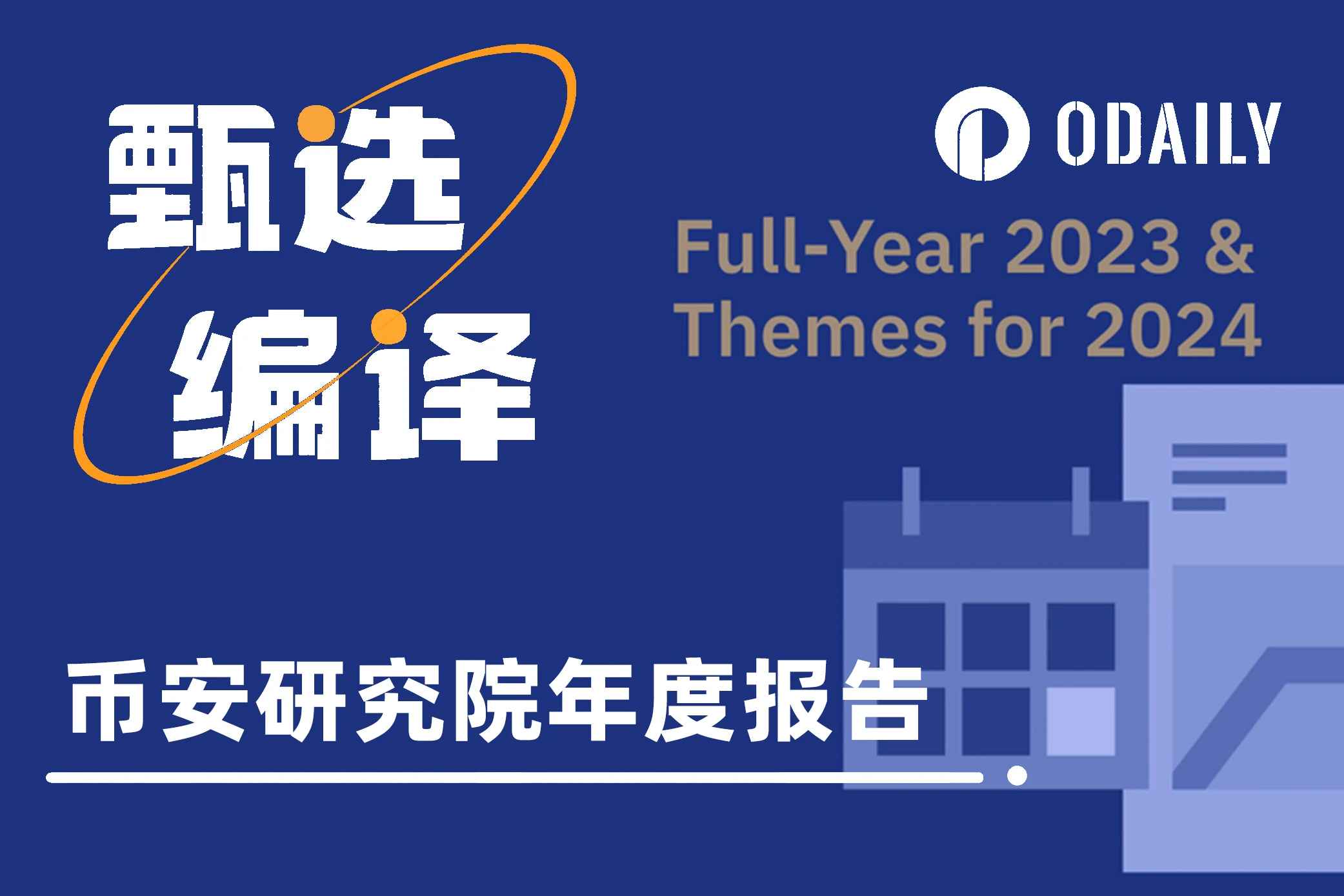Original author -Binance Research
Compiled - Odaily Nan Zhi

2023 review
2023 marks the year of recovery for the crypto market, with global crypto market capitalization growing by approximately 109%. This impressive growth was largely due to significant progress in the first and fourth quarters, which saw growth of 48.3% and 54.4% respectively. This is in sharp contrast to the difficult times of 2022, when the market fell by approximately 64%, driven by a series of volatile events including UST’s unanchoring, the bankruptcy of multiple lending institutions, and the FTX thunderstorm.
Key factors for strong performance in 2023 include a series of significant developments. The most critical of these is the optimism generated by spot Bitcoin ETFs and expectations for the upcoming Bitcoin halving. A strong macroeconomic backdrop (resilience in global GDP growth and moderating inflation) also creates a favorable environment for cryptocurrencies in 2023.
Despite the significant gains, 2023 is not without its challenges. In March, chaos in the banking sector affected the crypto market, causing the USDC stablecoin to temporarily unanchor. In August, traders suffered losses of up to $1 billion due to liquidations amid macroeconomic uncertainty related to the Chinese economy and signs that the Federal Reserve was considering further interest rate hikes. But the crypto market showed resilience, quickly recovering and regaining momentum in the following months.
As we look toward the future of the crypto market, the lessons of 2023 highlight the crypto industry’s ability to adapt, innovate, and grow in the face of challenges. A strong recovery in 2023 provides the crypto space with a foundation for more breakthroughs, growth, and possibilities.
Outlook 2024
Looking ahead, we are pleased with the markets excellent performance over the past year and look forward to the themes below.
The Bitcoin narrative remains at the forefront
Throughout 2023, Bitcoin has been in the spotlight thanks to various narratives such as Ordinals/BRC-20, the approval of a spot Bitcoin ETF and the 2024 halving. Ordinals and BRC-20 mark a 0-to-1 innovation in Bitcoin’s evolution, introducing the deployment, minting, and transfer of fungible tokens on the Bitcoin network for the first time. These tokens have also quickly become Alpha investment targets for investors in the Bitcoin ecosystem. Meanwhile, the recently approved spot ETF may introduce significant liquidity into the crypto market and mark mainstream recognition of Bitcoin as a legitimate asset.
Going into 2024, the momentum is likely to continue. The SEC’s final decision is out and it’s likely to be positive. Historically, crypto markets have performed well in the year following the Bitcoin halving event. Therefore, the recent approval of spot ETFs and optimism ahead of the April halving could trigger significant market volatility.
Additionally, due to Ordinals and BRC-20’s smaller market capitalization and meme-like nature, we may witness more dramatic price swings if Bitcoin rises rapidly in response to the corresponding event. It is expected that the Ordinals and BRC-20 ecosystem will further develop.Most notably, the launch of more Bitcoin scaling solutions like Stacks’ sBTC, would be an interesting development that would help enhance the functionality of Bitcoin.
Ownership economic applications gain further momentum
Blockchain technology enables users to regain sovereignty over resources traditionally controlled by large entities, including personal data, creative content, and computing resources. For example, centralized storage services may require users to relinquish control of their data, exposing them to the risk of privacy leaks and single points of failure. Various projects are exploring alternative solutions that give users greater control over their assets and information. in this regard,Two noteworthy areas are decentralized physical network infrastructure (DePin) and decentralized social media (DeSoc)。
Although the concepts of DePin and DeSoc have been around for some time, they only started to gain significant traction in 2023. This shift can be attributed to maturing infrastructure development, increased awareness, and the growth of the user base in the crypto space.For DeSoc, Friend.tech is key growth driver in 2023, generating huge revenue comparable to some of the top protocols. Friend.tech demonstrates the potential of decentralized social media, allowing users to monetize their creations without the limitations imposed by a central platform. In 2024, we may see similar apps exploring various forms of social media, including music, video, and written content.
Meanwhile, DePin becomes a hot narrative in late 2023. These protocols are seen as having high growth potential due to their large market size and ability to scale rapidly through bottom-up growth strategies. In 2024, we are likely to witness accelerated adoption of DePin and DeSoc projects, leveraging their potential for growth and market penetration.
Increased artificial intelligence (AI) integration
Since OpenAI’s ChatGPT sparked intense interest in AI applications around the world in 2023, AI and cryptography (AI x Crypto) has become one of the dominant narratives in recent months, with numerous projects continuing to emerge.We believe the integration of AI and crypto is a growth area to watch. Although it is still in its early stages, the integration of artificial intelligence in the crypto ecosystem opens up a range of possibilities regarding potential use cases and provides alternatives to existing solutions.
Projects that have begun integrating artificial intelligence have provided services such asTransaction automation, predictive analytics, generative art, data analytics and DAO operationsWaiting for service. Going forward, there are many more use cases yet to be discovered.
For example, training AI models requires massive data inputs and requires significant resources, often limiting this activity to tech giants. This leads to reduced transparency and closed development. However, by leveraging decentralized storage for data management, we can achieve greater transparency and security. This democratizes the AI model training process, allowing for wider participation, which could lead to a surge in innovation and development in the field.
Real World Assets (RWA) Growth
RWA tokenization demonstrates a powerful use case for blockchain technology. By bringing off-chain assets to the blockchain, RWA tokenization provides greater transparency and efficiency and opens up new realms of possibilities in terms of composability and potential use cases.
Going into 2024, we expect RWA to benefit from expectations of rate hikes.Tokenized treasuriesStill a bright spot, they offer crypto investors an alternative and attractive source of income. Additionally, as institutional adoption of RWA accelerates,Development of related infrastructure such as decentralized identity, oracles and interoperability solutions, is also expected to gain momentum. These elements are critical to building a comprehensive RWA ecosystem.
On-chain liquidity landscape is booming
Liquidity is critical to on-chain ecosystems, especially for DeFi. Since the introduction of the AMM model on Uniswap, there has been significant development. This evolution has given rise to multi-layered liquidity models that support a variety of on-chain activities, including token swaps, derivatives trading, and yield management.
As the market gradually gains momentum, on-chain liquidity and financial activity scale are expected to increase.Two categories to watch are liquidity management and request for quote (RFQ) systems. The centralized liquidity market maker (CLMM) promoted by Uniswap V3 solves the problem of insufficient capital efficiency. However, issues such as Impermanent Loss (IL) and Just-In-Time Liquidity (JIT), which require active position management, still pose problems for less experienced participants. This has led to the emergence of liquidity protocols that utilize various strategies to optimize CLMM liquidity provider positions. Currently, the TVL of Uniswap V3 alone reaches $2.4 billion, but the combined value managed by these liquidity management protocols is only $400 million. This gap highlights the potential for growth, especially with the upcoming launch of Uniswap V4, which may introduce more advanced liquidity optimization features.
RFQ systems, represented by projects including Uniswap X, CoW Swap and 1inch Fusion, facilitate matching between traders and market makers, often utilizing mechanisms such as Dutch auctions to ensure competitive pricing. Advantages of the RFQ model include competitive pricing, MEV protection, zero slippage, and gas-free order processing. As on-chain transaction infrastructure continues to advance, the likelihood of adopting such an efficient model is likely to increase.
Institutional Adoption Accelerates
2023 sees the arrival of institutions, and more can be expected to join the crypto space. During the past year’s bear market, well-established traditional asset management giants like BlackRock and Fidelity entered the crypto space, proving their confidence in the industry’s long-term potential.
Safety remains paramount
In the crypto industry, security plays a vital role in establishing and maintaining user trust, and according to DeFiLlama, losses from DeFi attacks exceeded $1 billion in 2023. Thats a significant improvement from 2022, when about $3.28 billion was stolen.
Given the importance of security, we expect to continue to focus on this area in 2024. This concern may take various forms, e.g.Product innovation, educational initiatives and user experience improvementswait.
Account abstraction becomes more important
To attract the next billion users and accelerate blockchain adoption, accessibility and inclusivity are critical. Ideally, users should be able to easily use the DApp and conduct any on-chain activity. However, there is actually still a lot of room for improvement. For example, most trading still occurs on centralized exchanges. Even at their peak in May 2023, decentralized exchanges still accounted for only 20% of total CEX trading volume.
There are several innovations that make us excited about the future. For example,Account abstractionPromotes the implementation of smart contract wallets with enhanced usability, with features such as social recovery, significantly improving the overall user experience. Given the fierce competition among wallet providers, we may see rapid growth.










